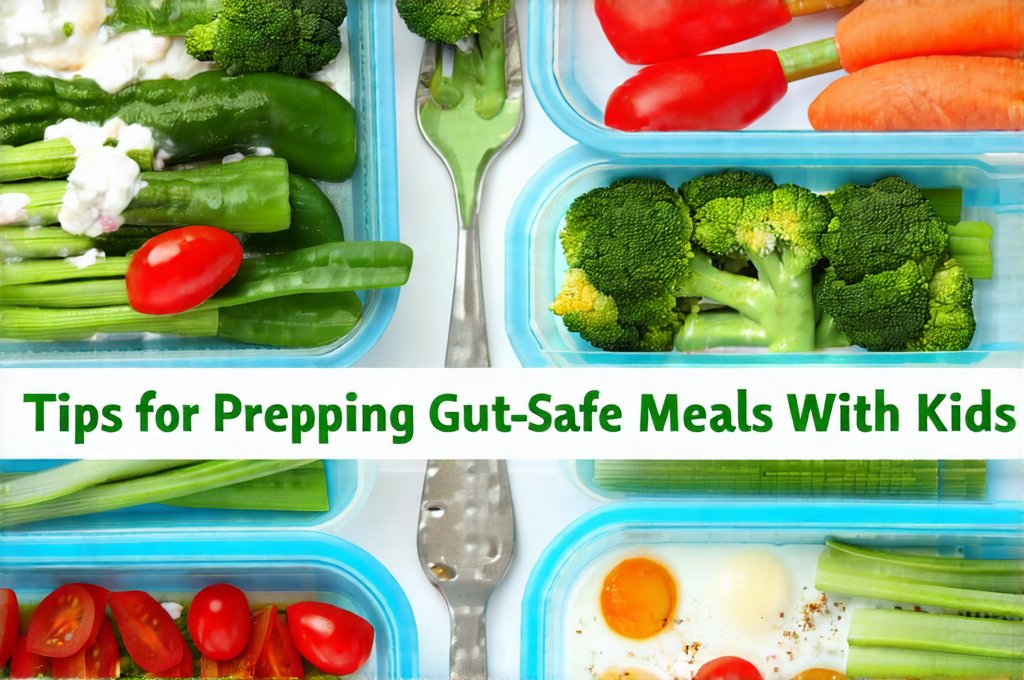Gut health is increasingly recognized as foundational to overall well-being, impacting everything from immunity and mood to energy levels and even cognitive function. For families, navigating dietary choices that support healthy guts can feel particularly challenging – especially when children are involved with their often selective palates and strong preferences! Many common foods, while seemingly harmless, can contribute to digestive distress or imbalance the gut microbiome in sensitive individuals. This is where “gut-safe” meal prepping comes into play: proactively planning and preparing meals that minimize potential irritants and prioritize ingredients known to nurture a thriving gut ecosystem.
The good news is building gut-friendly habits doesn’t require drastic changes or complex recipes. It’s about making informed choices, understanding individual sensitivities (which can vary greatly even within families), and most importantly, involving your kids in the process! This not only empowers them to understand their bodies better but also fosters a positive relationship with food and healthy eating. Preparing gut-safe meals with children is an excellent opportunity for education – teaching about digestion, the microbiome, and how different foods affect our bodies—making it less of a chore and more of a family learning experience. It’s about building sustainable habits, not restrictive diets. Understanding daily microbiome maintenance tips is essential for long-term gut health.
Decoding Gut Irritants & Building Blocks
Identifying potential gut irritants is the first step in creating gut-safe meals. Common culprits include highly processed foods, excessive sugar, artificial sweeteners, certain food additives (like emulsifiers), and for some individuals, specific carbohydrates known as FODMAPs (Fermentable Oligosaccharides, Disaccharides, Monosaccharides And Polyols). It’s crucial to remember that tolerance varies significantly. What bothers one person won’t necessarily affect another. However, a general rule of thumb is to prioritize whole, unprocessed foods whenever possible. Focusing on building blocks for gut health – fiber-rich fruits and vegetables, fermented foods (yogurt, kefir, sauerkraut), lean proteins, and healthy fats – will lay the foundation for thriving digestive systems.
Involving kids in identifying these “building blocks” can be fun! A simple game of “What’s Good For Our Tummies?” can help them learn about beneficial foods. You could even create a visual chart with pictures of gut-friendly options and discuss how they support our bodies. Remember, it’s not about demonizing certain foods entirely; it’s about mindful consumption and finding balance. A small treat now and then won’t derail your efforts if the majority of their diet is focused on nourishing choices. Planning ahead can be especially helpful when eating while traveling or facing other disruptions to routine.
A key aspect to remember when prepping meals for sensitive guts – especially children’s – is simplification. Complex recipes with long ingredient lists often increase the risk of hidden irritants. Stick to simple, wholesome recipes that highlight fresh ingredients and minimize processing. This makes it easier to identify potential issues if a reaction occurs and allows you to tailor the meal to your child’s specific needs.
Making Meal Prep Family Fun
Meal prepping doesn’t have to be a solitary activity! In fact, involving kids in the process is one of the most effective ways to encourage healthy eating habits and foster a positive relationship with food. Assign age-appropriate tasks: younger children can help wash vegetables or tear lettuce, while older children can assist with measuring ingredients or stirring mixtures. Turn it into a collaborative effort, allowing them to choose recipes (within gut-safe parameters) and contribute to the planning process.
This isn’t just about getting help in the kitchen; it’s about educating your children about food preparation and nutrition. Explain why you’re choosing certain ingredients over others and how they benefit their bodies. For example, while making a smoothie with kefir, explain that fermented foods like kefir contain “good bacteria” that help keep our tummies happy. Make it an interactive learning experience! It can also be a great opportunity to teach basic kitchen skills – safe knife handling (for older children), measuring techniques, and food safety practices.
Consider dedicating one day a week to meal prepping together as a family. This creates a routine and ensures you have gut-safe meals readily available throughout the week, reducing stress during busy weekdays. Don’t strive for perfection; focus on progress and celebrate small victories. Even if it’s just chopping vegetables or portioning out snacks, any contribution is valuable. If you struggle with indigestion yourself, hosting guests can be easier with a little preparation!
Navigating Picky Eaters
Picky eating is a common challenge for many parents, but it doesn’t have to derail your gut-safe meal prepping efforts. The key is patience, persistence, and creativity. Don’t force your child to eat anything they don’t want to – this can create negative associations with food. Instead, focus on offering a variety of options and presenting foods in appealing ways.
- Sneak it in: Puree vegetables into sauces or add them to baked goods (zucchini bread, carrot muffins).
- Presentation matters: Cut fruits and vegetables into fun shapes or arrange them creatively on the plate.
- Dip it! Serve vegetables with hummus or yogurt-based dips.
- Get them involved: Let your child help choose recipes or prepare their own plates (with guidance).
Remember, it can take multiple exposures to a new food before a child accepts it. Don’t give up after one attempt! Continue offering the food in different ways and at different times. Focus on creating a positive mealtime environment where eating is enjoyable, not stressful. And remember, small changes over time are more sustainable than drastic interventions. When facing digestive issues, low-effort meals can be a lifesaver!
Fermented Foods for Kids
Fermented foods are nutritional powerhouses, packed with probiotics that support a healthy gut microbiome. However, introducing them to children requires a gentle approach. Start with small amounts and choose mild options like yogurt or kefir. Some children may be sensitive to the taste or texture of fermented foods, so experiment with different brands and flavors until you find one they enjoy.
- Yogurt: Choose plain, unsweetened yogurt and add your own fruit or a drizzle of honey (in moderation).
- Kefir: Similar to yogurt but often more palatable for children due to its drinkable consistency.
- Sauerkraut/Kimchi: Introduce these gradually, starting with very small portions mixed into other foods.
It’s important to note that not all fermented foods are created equal. Look for products labeled “live and active cultures” to ensure they contain beneficial probiotics. You can also make your own fermented foods at home – it’s a fun project to do with kids! Just be sure to follow proper fermentation techniques to avoid contamination.
Simple Gut-Safe Snack Ideas
Snacks are an important part of any child’s diet, but they can also be a source of gut irritants. Avoid processed snacks like crackers, cookies, and sugary cereals. Instead, opt for whole food options that nourish the gut microbiome. Here are some simple ideas:
- Fruit with nut butter: Apples slices with almond butter or banana with peanut butter (check for allergies).
- Vegetable sticks with hummus: Carrots, celery, or cucumber dipped in homemade hummus.
- Yogurt parfait: Layers of plain yogurt, berries, and a sprinkle of granola (choose a low-sugar option).
- Hard-boiled eggs: A great source of protein and healthy fats.
- Rice cakes with avocado: A simple and satisfying snack.
Preparation is key! Having these snacks readily available will make it easier to resist the temptation to reach for unhealthy options. Pack them in reusable containers for on-the-go snacking. And remember, modeling healthy eating habits is one of the most powerful things you can do as a parent. If your children see you enjoying gut-safe snacks, they’re more likely to embrace them too! For those times when dining out feels daunting, consider these eating in public tips.


















